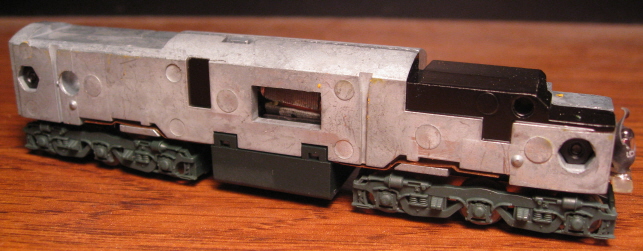



Introduced: 2002
These Erie-Builts are great looking and sweet running locos. Unfortunately, they're a bit difficult to find these days. As of this writing (2008), there's just been the one production run - and a very limited run at that. They were available in powered A/B sets or just singleton A's.
The chassis / mechanism is very much similar to the one used in Life-Like's 2000 Alco FA-1/FB-1 and 2001 C-Liner models (albeit much longer) -

The chassis is all-metal and split-frame. The current collection scheme is of the "low-friction" ilk. The motor is an open-sided, skew-wound 5-poler (spinning dual flywheels). All wheels provide pickup (no traction tires). Eight of the twelve wheels are geared (the center axles on each truck being free-spinners). All gearing is plastic. Wheels are blackened and low-profile (no problems on Code 55 rails). Couplers are shell-mounted. The pilot coupler is a knuckle, whereas the rest are Rapidos (and easily swapped out for MT's). A non-directional headlight is mounted to a small PC board on the front of the chassis (unfortunately, it uses a filament bulb rather than an LED). Also unfortunate is the complete lack of support for DCC - a bit of a disappointment for a 2002 locomotive release.
These models are sensational runners in all respects - whisper quiet, great pickup, great throttle response, great slow-speed creep, reasonable top-end speed, exceptional pulling power, etc.
As mentioned above, the Rapido couplers are easily converted to Micro-Trains. However, I've had more than my fair share of problems with the clip / bracket system that holds said couplers in place (first introduced on Life-Like's 2001 C-Liner models). The bracket is simply glued to the shell, and removing the clip that holds the coupler will often dislodge the bracket (requiring that it be re-glued). So no, not a particularly elegant design.
Another minor annoyance - the A unit's airhorn is easily dislodged and extremely difficult to reattach (if you can even find it). So, watch your fumblefingers when handling these things!
The Erie-built chassis is basically the same (although not exactly the same) as Life-Like's newer vintage (2005) PA's. From what I can tell, the main difference is that the EB's chassis tapers a bit at the nose to accommodate the shell (whereas the PA chassis is pretty much rectangular from stem to stern).
The shells are a bit stubborn when it comes to pulling them off the chassis. Basically you need to insert four toothpicks between the chassis and shell (near the four chassis "bumps" that lock into the shell - found above the trucks). Once the shell is freed from the bumps, it should lift up and off (although it does take a bit of finagling). The lightboard on the "A" units can become a bit of a sticking point (getting hung up on the pilot coupler). If that turns out to be the case, just remove the coupler and its mounting brace.
Grade: A
Reviewed: 10/02 Model Railroader ("Life-Like's newest N scale locomotive is a nicely detailed, smooth-running model of the uncommon Fairbanks-Morse six-axle, 2000-hp "Erie-Built"... Life-Like's model duplicates the prototype's wheel arrangement and comes with the conventional drop-equalizer trucks used on some Erie-Builts. The General Steel Castings trucks were similar to the trucks under Alco PA-1s, so Life-Like has used the Alco trucks on these models to reduce costs. Those trucks are well-molded with good relief detail, but omit FM's middle brake cylinder to provide clearance for the truck to swivel behind the cab side ladders on sharp model railroad curves. This all-new model is made in China and is built around a vertically split cast-zinc alloy frame. It has a five-pole skew-wound double-ended motor that's isolated from the frame except for the two brush holder contacts. Power from the rails is conducted from all 12 wheels through brass bearing wipers contacting the steel axles. Phosphor bronze pickups transfer the current to the frame halves. A pair of turned-brass flywheels and a drive train made from acetal plastic gears with steel drive shafts and brass worms deliver smooth tractive effort. The wheels are chemically darkened and meet NMRA standards for gauge and flange depth. However, some wheel treads on our sample were slightly narrow.
"The front coupler is a dummy knuckle-style and its height is low. The rear coupler is a Rapido-style that's body mounted for easier replacement. Life-Like did not include provisions for the addition of a decoder... The Erie-builts major dimensions closely match prototype drawings... The body shell's mold work nicely captures the lines and nuances of the prototype. Painting and lettering are excellent throughout, and the locomotive designation under the road number on the side may be the smallest I've ever seen, but it's clearly legible under magnification. Life-Like has applied silver paint on the classification light lenses... The headlight is non-directional and glows quite brightly... Performance is where the model really shines. Although somewhat noisy at the middle and higher speeds, it needs little current to start moving and keep moving. Weighing in at a robust 5.75 ounces, a single unit is capable of pulling 46 cars. The model will negotiate a 9 3/4" radius curve... Despite the lack of easy DCC conversion and presence of a Rapido-style coupler, N scalers looking for classic first-generation motive power will be quite pleased with this model. Single A Unit: C&NW, KCS, MR, NYC, PRR, SF, UP. A & B Units: KCS, MR, NYC, PRR, SF, UP, Undec.")